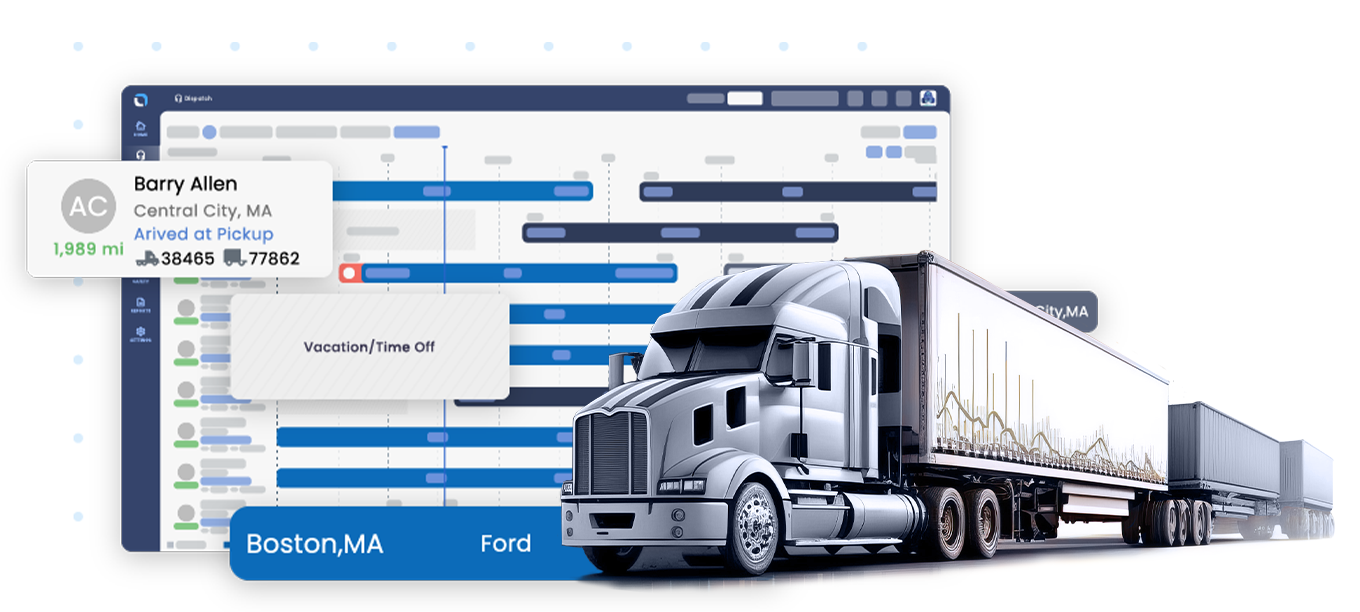Trucking technology to the rescue
Read to learn about the increasing competition in the US trucking industry
In today's rapidly evolving transportation landscape, the efficiency and sustainability of fleet operations have never been more critical.
In today's rapidly evolving transportation landscape, the efficiency and sustainability of fleet operations have never been more critical. Fleet management stands at the forefront of this transformation, offering a strategic approach to optimizing the performance and profitability of fleet activities. This blog post delves into the intricacies of fleet management, exploring its key components, challenges, and technology’s impact in the field.
| In the blog: |
| 1. What is fleet management? |
| 2. What are the main components of fleet management? |
| 3. What is fleet management software? |
| 4. Most common features in fleet management software. |
| 5. Fleet management software benefits. |
| 6. Companies using technology to leverage operations. |
Fleet management is a comprehensive set of activities and processes to handle fleet operations and ensure efficiency, timeliness, and adequate financial performance. The main goal of a fleet manager is to guarantee that every truck is utilized to its fullest potential by reducing downtime and operational costs while maximizing productivity and profitability.
The core objectives of driver management are optimizing driver performance, ensuring safety on the road, and retaining good drivers. Fleet managers are responsible for guaranteeing adherence to road regulations and legal requirements, including respecting hours of service (HoS), maintaining valid insurance, and conducting regular inspections.
As surprising as it may sound, driver management is not just about productivity; it’s also about keeping drivers happy. Given the rising costs associated with recruiting new drivers—$8,234 on average—retaining top talent is more important than ever. See the following resources to help implement retention strategies that reduce recruitment and training costs:
Asset management ensures that each truck is utilized efficiently, appropriately maintained, and replaced at the optimal time to minimize risks of failure and costs. Fleet managers monitor the entire lifecycle of an asset from its acquisition to its disposal and replacement. When it comes to asset management, decisions should be based on the total cost of ownership (TCO) of the fleet, which accounts for capital costs, maintenance, asset depreciation, and licensing and registration costs. Fleet managers are running the show behind the scenes to guarantee that every truck is in adequate condition and to all drivers are safe.
As transportation industry costs continue to increase, gaining visibility into the actual operational expenses has become essential for staying in business. Fleet managers play a critical role in monitoring these costs and striving to enhance profitability and efficiency within their fleet operations.
One significant challenge they face is the diversity and fluctuation of operational costs in the transportation industry, which include fuel consumption, driver salaries, insurance, and leasing expenses. Often, these records are siloed across spreadsheets, databases, and files, making the task of obtaining timely insights extremely difficult. This challenge is one of the primary motivations for investing in software solutions to support fleet operations.
In addition to tracking cost-related metrics, fleet managers oversee things like dwell time, route efficiency, and driver performance. While dispatchers assign loads to drivers and plan schedules daily, fleet managers are more interested in looking at the big picture of how those decisions contribute to or threaten operational efficiency in the fleet. It’s through identifying key insights like who the best-performing drivers are, what the most effective routes are, and what trucks or vehicles are experiencing more incidents that fleet managers can propose solutions to optimize operations.

Fleet management software is a comprehensive tool designed to help companies oversee, manage, and streamline their truck operations from a centralized platform. This technology is crucial for businesses in the transportation sector, aiming to mitigate risks associated with equipment failures, increase productivity and efficiency, and minimize the overall costs tied to drivers and operations.

Most fleet management systems integrate with telematic solutions, enabling real-time tracking of location, movement, and status of vehicles. This feature is fundamental for maintaining visibility and control over fleet assets.
These solutions include modules dedicated to optimizing the maintenance workflow. They automate the creation of preventive maintenance schedules, maintain a comprehensive service history for each asset, and send timely inspection reminders, ensuring the fleet remains in top condition.
Decision-making is simplified with intuitive reports and dashboards that keep fleet managers informed about their fleet's operations. If managing data through spreadsheets has been a challenge, this feature helps teams easily view and analyze fleet information by connecting all data.
With fuel being a significant operational expense, many fleet management solutions offer modules to track fuel consumption. This visibility allows managers to identify trends and inefficiencies in fuel use, paving the way for cost-saving measures.
 Route monitoring and optimization
Route monitoring and optimization This is a critical feature for any fleet management software. Tools like LoadAi enable dispatchers to efficiently monitor, plan, and adjust routes by considering predictable elements like driver availability, delivery windows, distances, and even unpredictable factors such as traffic and delays. These features are vital for enhancing route efficiency and operational adaptability in real time.

From tracking truck locations to optimizing routes, fleet management software ensures that every asset is used to its fullest potential, minimizing dwellings and maximizing delivery efficiency. The ability to quickly access trucks and drivers’ availability and restrictions helps managers make informed decisions about fleet allocation and scheduling, ensuring the right driver is available for the right load at the right time.
Adopting a software solution to manage fleets helps reduce operational costs, especially fuel consumption and empty miles, by optimizing routes and providing insights on fleet utilization. As a result, transportation companies can decrease wear and tear on their assets and extend their assets' lifespans.
Many of the solutions in the market simplify the process of meeting regulatory requirements, including adherence to driving hours and maintenance standards. Using technology can help avoid fines and penalties associated with non-compliance and ensure that fleet operations are always in line with the latest regulations and standards, thereby safeguarding reputation and minimizing legal risks.
Technology allows fleet managers to move from a reactive approach to a proactive approach in their maintenance planning. Through alerts and scheduling features, managers can expect significant savings on repairs, downtime reduction, and an extended lifespan of the fleet.
Fleet management tools help managers track speeding, hard braking, and sudden acceleration. This information can be used to identify risky driving habits and provide training to improve safety. Also, some systems can notify management automatically of collisions or malfunctions, allowing for a quicker response to the incidents.
By optimizing routes and ensuring vehicles are appropriately maintained, fleet management software can help reduce fuel consumption and emissions, contributing to the environmental sustainability of fleets.
Fleet management software automates many tasks that would otherwise require manual input, such as collecting data from different systems and integrating it for analysis. Additionally, by digitalizing records, these tools reduce the need for manual paperwork and simplify storing, searching, and retrieving documents or data for administrative tasks like preparing reports and tax preparation.
Many transportation companies are already using technology to scale their fleet operations and improve productivity. The following case studies show how software can help companies overcome challenges and improve profitability.

With a network of over 6,000 power units and 20,000 trailers, Saia is one of the largest LTL carriers in the United States. In 2020, they incorporated RouteMax, a route optimization software, a dynamic route optimization software designed to streamline and speed pickup and delivery operations.
By facilitating quick and accurate route building, the software empowers Saia's inbound planners to consistently meet service commitments while minimizing operational expenses across all 169 terminals. Rohit Lal, Saia’s Executive Vice President and Chief Information officer, said, “[they] recognized quite early that these tools gave [them] the ability to be more efficient and more productive”

Southeastern Freight Lines is a regional less-than-truckload carrier operating 89 service centers in 13 states, Canada, and Puerto Rico. They implemented a network optimization and driver schedule optimization system to streamline operations. Melissa Atkin, Vice President of Linehaul Transportation said “, As Southeastern focuses on continuously creating value for our customers and delivering quality without question, we have identified Optym products as a way to enable us to reach new levels of efficiency and quality"

Estes, the largest, privately-owned freight carrier in North America, incorporates DriverPlan to optimize driver schedules. This tool unlocked visibility and added efficiency to their network while creating better driver routes through LTL-specific algorithms, simulation trailer assignments to meet service standards, and What-if scenario modeling to help planners understand how new schedules or updates impact operations and performance. “With DriverPlan, we will create more scheduled runs, which benefits the consistency of our operations and makes drivers happier by giving them more consistent work,” Estes VP of Process Improvement Webb Estes said. “Drivers get more miles on average because DriverPlan better utilizes drivers. Plus, we can design schedules where drivers get to spend more nights at home with their families."
Read to learn about the increasing competition in the US trucking industry
Discover how this dispatching software simplifies digital document management with instant transfer, frequent backups, and intelligent automation.
Learn how to dispatch trucks from home using cloud-based software and AI solutions like Load AI and RouteMax.
Keep up to date with industry trends, news, and more.